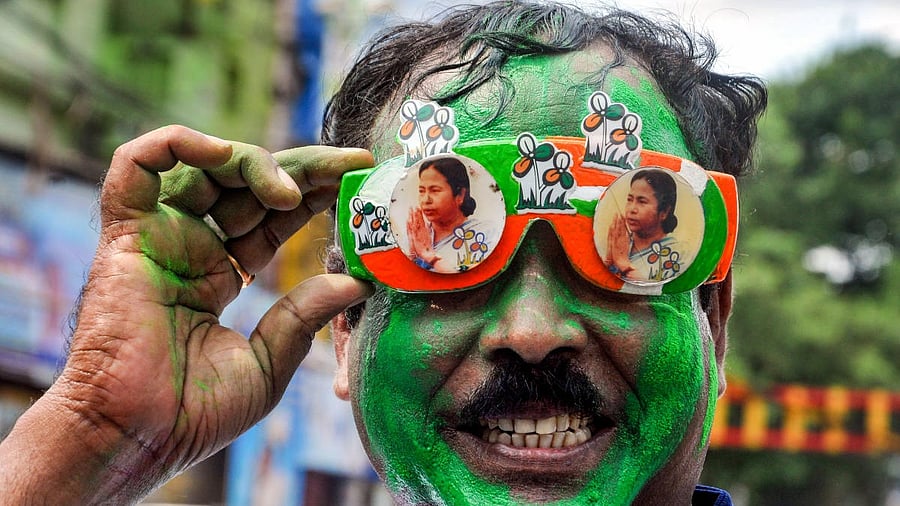
Trinamool Congress (TMC) supporter.
Credit: PTI Photo
The Bharatiya Janata Party (BJP) got into campaign stride for the 2024 Lok Sabha elections with a stridently sectarian pitch amplified by the assembly election megaphone.
We know what stick it wields to wrest states not yet in its control because we will get a sneak preview on December 24, when the West Bengal unit of the party hosts a programme headlined ‘Lokkho Konthe Gita Path’ — Bhagwat Gita readings in one hundred thousand voices — at the Kolkata Maidan. Prime Minister Narendra Modi, who was expected to attend the event, will not be attending it “due to unavoidable reasons”.
The BJP has been trying relentlessly to polarise West Bengal along communal lines for the past decade. In political terms, it has succeeded, but in a way that has boomeranged on it. In the 2021 assembly elections, it got 38 per cent of the 82.3 per cent of votes cast but ended up with 77 of 292 the seats for which polls were held. What it did manage also to do, because the party’s understanding of India’s subcontinental diversity is kindergarten level, was to mobilise the considerable anti-sangh vote unremittingly behind the Trinamool Congress (TMC), which won 215 seats with over 48 per cent of the vote. The Congress and Left Front were squeezed out.
Nevertheless, we must note that the BJP did succeed in mobilising the Hindu vote behind it. What does this tell us about communitarian social identities and political cleavages in West Bengal? Let’s note one more thing. The Rashtriya Swayamsevak Sangh (RSS), which provides the BJP a not inconsiderable part of its organisational strength, has grown substantially in West Bengal since 2013. There are no independent estimates, but the RSS itself claims the number of shakhas grew from 750 that year to 1,279 in 2018. Some leaders claim it continued to grow through the Covid-19 period, though neither a hard number nor rough distribution is known. Nevertheless, the RSS is known to be influential in the tribal areas, and in Howrah, Hooghly, and Purba Medinipur districts.
The BJP relies for its social mobilisation on this RSS base, because even now, after strenuous efforts, and the expenditure of vast amounts of the dodgy finances it controls, at cracking West Bengal, its organisation remains patchy. That can be inferred from its wildly oscillating vote share in recent elections: 17 per cent in 2014; 10.16 per cent in 2016; 41 per cent in 2019; and 38 per cent in 2021. The impressive rise in vote share since the 2011 assembly elections, when it got 4 per cent of the vote, has been mostly at the expense of the CPI(M) and other Left parties, but has also taken a bit of a beating since 2021 with a bit of a Left revival. In the 2022 municipal elections, the BJP’s vote share was 13 per cent and in the 2023 panchayat elections, it was 23 per cent.
To what extent voting patterns in local elections follow a different trend from state and national elections is a moot issue. Historically, the trends tend to be the same, even if the numbers vary. But whichever way electoral numbers pan out, the question of whether the sangh parivar has succeeded in polarising West Bengal remains important.
First, it’s not exactly true that Bengali society has been immune from sectarian divisions for the past 75 years. You wouldn’t expect it, given the history of Partition and the large population of displaced people that has harboured a residual bitterness which taints collective memories. It was politically sublimated for many decades, just as the caste question was, but the fact that there was an en masse transfer of the Left vote to the BJP must tell us something.
As must an appeal made by Chief Minister Mamata Banerjee on November 23: “The RSS… please do not endorse those who did the greatest damage to the nation. Please do not keep supporting the two that have destroyed the country.” The attempt to enlist the ideological forebear of majoritarian obscurantism to fight sectarianism is a telling symbol of how far the sangh parivar has moved the needle rightwards in West Bengal and the whole country.
The very fact that politically the majority of people have mobilised to prevent the BJP’s ascension and the fact that Right-wing outfits remain marginal both metaphorically and territorially — i.e. confined to pockets — means that West Bengal has successfully resisted the blandishments of the BJP and other Hindutva forces.
It’s likely that unless the BJP jettisons its divisive heartland idiom, it will have to remain mostly quiet on the eastern front.
(Suhit K Sen is author of ‘The Paradox of Populism: The Indira Gandhi Years, 1966-1977’.)
Disclaimer: The views expressed above are the author's own. They do not necessarily reflect the views of DH.